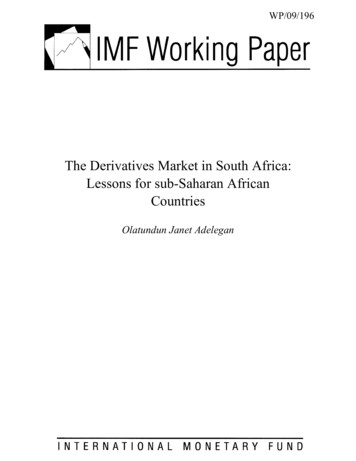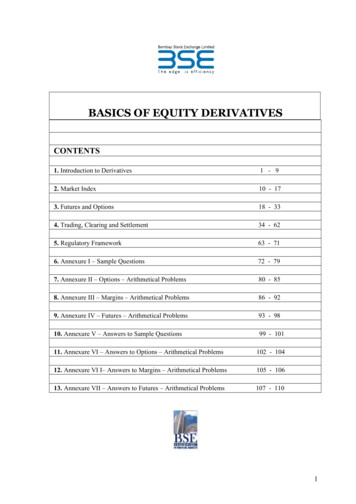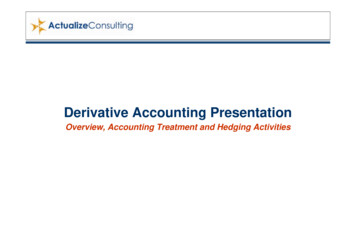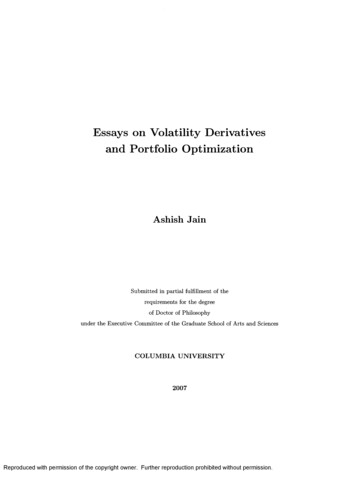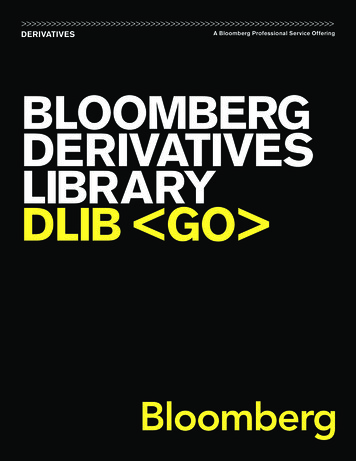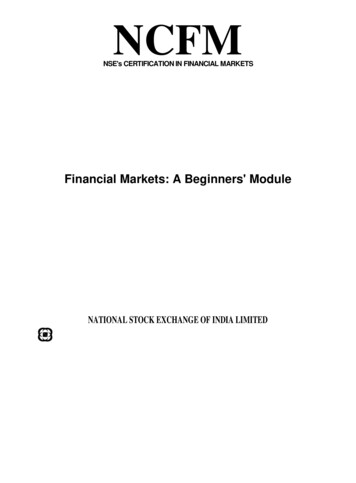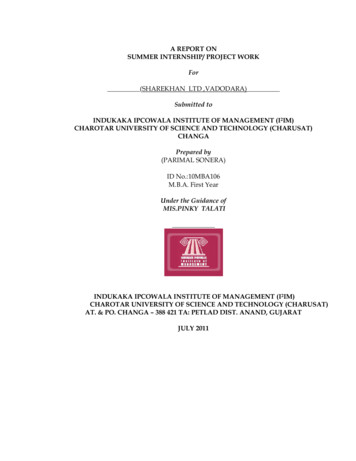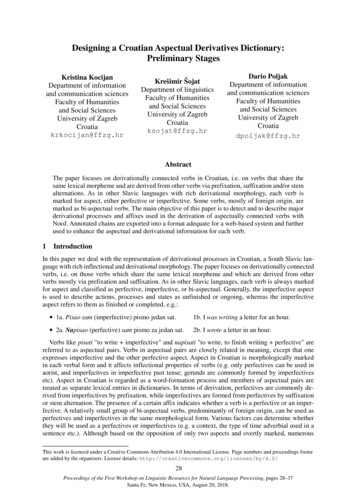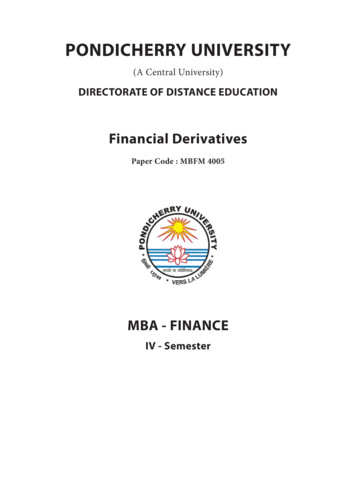
Transcription
PONDICHERRY UNIVERSITY(A Central University)DIRECTORATE OF DISTANCE EDUCATIONFinancial DerivativesPaper Code : MBFM 4005MBA - FINANCEIV - Semester
AuthorDr. R. KasilingamReader,Department of Management Studies,Pondicherry UniversityPuducherry.All Rights ReservedFor Private Circulation OnlyISBN 978-93-81932-16-2
TABLE OF CONTENTSUNITIIIIIIIVVLESSONTITLEPAGE NO.1.1Basics of Financial Derivatives41.2Forward Contracts331.3Participants in Derivative Markets461.4Recent Developments in Global Financial Derivative Markets522.1Basics of Options682.2Fundamental Determinants of Option’s Price792.3Options Trading Strategies982.4Interest rate swaps1552.5Currency Swaps1713.1Futures Market2063.2Pricing of Futures2233.3Theories of Futures Prices2344.1Hedging Strategy Using Futures2664.2Basis Risk and Hedging2804.3Stock Index2895.1Financial Derivatives Markets in India3195.2Benefits of Derivatives in India329
MBA Finance – IV SemesterPaper code: MBFM 4005Paper – XXFinancial DerivativesObjectives To Understand the students about the concept of Derivatives and its types To acquaint the knowledge of Options and Futures and To know about Hedging and the development position of Derivatives in India.Unit – IDerivatives – Features of a Financial Derivative – Types of Financial Derivatives– Basic Financial derivatives – History of Derivatives Markets – Uses of Derivatives –Critiques of Derivatives – Forward Market: Pricing and Trading Mechanism – ForwardContract concept – Features of Forward Contract – Classification of Forward Contracts –Forward Trading Mechanism – Forward Prices Vs Future Prices.Unit – IIOptions and Swaps – Concept of Options – Types of options – Option Valuation– Option Positions Naked and Covered Option – Underlying Assets in Exchange-tradedOptions – Determinants of Option Prices – Binomial Option Pricing Model – Black-ScholesOption Pricing – Basic Principles of Option Trading – SWAP: Concept, Evaluation andFeatures of Swap – Types of Financial Swaps – Interest Rate Swaps – Currency Swap – DebtEquity Swap.Unit – IIIFutures – Financial Futures Contracts – Types of Financial Futures Contract –Evolution of Futures Market in India – Traders in Futures Market in India – Functionsand Growth of Futures Markets – Futures Market Trading Mechanism - Specification of1
the Future Contract – Clearing House – Operation of Margins – Settlement – Theories ofFuture prices – Future prices and Risk Aversion – Forward Contract Vs. Futures Contracts.Unit – IVHedging and Stock Index Futures – Concepts – Perfect Hedging Model – Basic Longand Short Hedges – Cross Hedging – Basis Risk and Hedging – Basis Risk Vs Price Risk –Hedging Effectiveness – Devising a Hedging Strategy – Hedging Objectives – Managementof Hedge – Concept of Stock Index – Stock Index Futures – Stock Index Futures as a Portfoliomanagement Tool – Speculation and Stock Index Futures – Stock Index Futures Trading inIndian Stock Market.Unit – VFinancial Derivatives Market in India – Need for Derivatives – Evolution ofDerivatives in India – Major Recommendations of Dr. L.C. Gupta Committee – EquityDerivatives – Strengthening of Cash Market – Benefits of Derivatives in India – Categoriesof Derivatives Traded in India – Derivatives Trading at NSE/BSE – Eligibility of Stocks –Emerging Structure of Derivatives Markets in India -Regulation of Financial Derivatives inIndia – Structure of the Market – Trading systems – Badla system in Indian Stock Market– Regulatory Instruments.References1. Gupta S.L., FINANCIAL DERIVATIVES THEORY, CONCEPTS AND PROBLEMSPHI, Delhi, Kumar S.S.S. FINANCIAL DERIVATIVES, PHI, New Delhi, 20072. Chance, Don M: DERIVATIVES and Risk Management Basics, Cengage Learning, Delhi.3. Stulz M. Rene, RISK MANAGEMENT & DERIVATIVES, Cengage Learning, New Delhi.2
UNIT - IUnit StructureLesson 1.1 - Basics of Financial DerivativesLesson 1.2 - Forward ContractsLesson 1.3 - Participants in Derivative MarketsLesson 1.4 - Recent Developments in Global Financial Derivative MarketsLearning ObjectivesAfter reading this chapter, students should Understand the meaning of financial derivatives. Know that what various features of financial derivatives are. Understand the various types of financial derivatives like forward, futures, options,Swaps, convertible, warrants, etc. Know about the historical background of financial derivatives. Know that what various uses of financial derivatives are. Understand about the myths of financial derivatives. Understand the concept of forward contract. Be aware about the various features of a forward contract. Know that forward markets as fore-runner of futures markets, and also know aboutthe historically growth of forward market. Understand the various differences between futures and forward contracts. Know about the classification of forward contracts like hedge contracts, transferablespecific delivery, and non-transferable specific delivery (NTSD) and other forwardcontracts.3
Lesson 1.1 - Basics of Financial DerivativesIntroductionThe past decade has witnessed the multiple growths in the volume of internationaltrade and business due to the wave of globalization and liberalization all over the world.As a result, the demand for the international money and financial instruments increasedsignificantly at the global level. In this respect, changes in the interest rates, exchange ratesand stock market prices at the different financial markets have increased the financialrisks to the corporate world. Adverse changes have even threatened the very survival ofthe business world. It is, therefore, to manage such risks; the new financial instrumentshave been developed in the financial markets, which are also popularly known as financialderivatives.The basic purpose of these instruments is to provide commitments to prices forfuture dates for giving protection against adverse movements in future prices, in orderto reduce the extent of financial risks. Not only this, they also provide opportunities toearn profit for those persons who are ready to go for higher risks. In other words, theseinstruments, indeed, facilitate to transfer the risk from those who wish to avoid it to thosewho are willing to accept the same.Today, the financial derivatives have become increasingly popular and mostcommonly used in the world of finance. This has grown with so phenomenal speed allover the world that now it is called as the derivatives revolution. In an estimate, the presentannual trading volume of derivative markets has crossed US 30,000 billion, representingmore than 100 times gross domestic product of India.Financial derivatives like futures, forwards options and swaps are important tools tomanage assets, portfolios and financial risks. Thus, it is essential to know the terminologyand conceptual framework of all these financial derivatives in order to analyze and managethe financial risks. The prices of these financial derivatives contracts depend upon the spotprices of the underlying assets, costs of carrying assets into the future and relationshipwith spot prices. For example, forward and futures contracts are similar in nature, but theirprices in future may differ. Therefore, before using any financial derivative instruments forhedging, speculating, or arbitraging purpose, the trader or investor must carefully examineall the important aspects relating to them.4
Definition of Financial DerivativesBefore explaining the term financial derivative, let us see the dictionary meaning of‘derivative’. Webster’s Ninth New Collegiate Dictionary (1987) states Derivatives as:1. A word formed by derivation. It means, this word has been arisen by derivation.2. Something derived; it means that some things have to be derived or arisen out ofthe underlying variables. For example, financial derivative is an instrument indeedderived from the financial market.3. The limit of the ratio of the change is a function to the corresponding change in itsindependent variable. This explains that the value of financial derivative will changeas per the change in the value of the underlying financial instrument.4. A chemical substance related structurally to another substance, and theoreticallyderivable from it. In other words, derivatives are structurally related to othersubstances.5. A substance that can be made from another substance in one or more steps. Incase of financial derivatives, they are derived from a combination of cash marketinstruments or other derivative instruments.For example, you have purchased gold futures on May 2003 for delivery in August2003. The price of gold on May 2003 in the spot market is 4500 per 10 grams and forfutures delivery in August 2003 is 4800 per 10 grams. Suppose in July 2003 the spot priceof the gold changes and increased to 4800 per 10 grams. In the same line value of financialderivatives or gold futures will also change.From the above, the term derivatives may be termed as follows:The term “Derivative” indicates that it has no independent value, i.e., its valueis entirely derived from the value of the underlying asset. The underlying asset can besecurities, commodities, bullion, currency, livestock or anything else.In other words, derivative means forward, futures, option or any other hybridcontract of predetermined fixed duration, linked for the purpose of contract fulfillment tothe value of a specified real or financial asset or to an index of securities.The Securities Contracts (Regulation) Act 1956 defines “derivative” as under:5
“Derivative” includes1. Security derived from a debt instrument, share, loan whether secured or unsecured,risk instrument or contract for differences or any other form of security.2. A contract which derives its value from the prices, or index of prices of underlyingsecurities.The above definition conveys that1. The derivatives are financial products.2. Derivative is derived from another financial instrument/contract called theunderlying. In the case of Nifty futures, Nifty index is the underlying. A derivativederives its value from the underlying assets. Accounting Standard SFAS133 defines aderivative as, ‘a derivative instrument is a financial derivative or other contract withall three of the following characteristics:(i)It has (1) one or more underlings, and (2) one or more notional amountor payments provisions or both. Those terms determine the amount of thesettlement or settlements.(ii)It requires no initial net investment or an initial net investment that is smallerthan would be required for other types of contract that would be expected tohave a similar response to changes in market factors.(iii)Its terms require or permit net settlement. It can be readily settled net by ameans outside the contract or it provides for delivery of an asset that puts therecipients in a position not substantially different from net settlementIn general, from the aforementioned, derivatives refer to securities or to contractsthat derive from another—whose value depends on another contract or assets. As suchthe financial derivatives are financial instruments whose prices or values are derived fromthe prices of other underlying financial instruments or financial assets. The underlyinginstruments may be a equity share, stock, bond, debenture, treasury bill, foreign currencyor even another derivative asset. For example, a stock option’s value depends upon thevalue of a stock on which the option is written. Similarly, the value of a treasury bill offutures contracts or foreign currency forward contract will depend upon the price orvalue of the underlying assets, such as Treasury bill or foreign currency. In other words,the price of the derivative is not arbitrary rather it is linked or affected to the price of theunderlying asset that will automatically affect the price of the financial derivative. Due tothis reason, transactions in derivative markets are used to offset the risk of price changes6
in the underlying assets. In fact, the derivatives can be formed on almost any variable, forexample, from the price of hogs to the amount of snow falling at a certain ski resort.The term financial derivative relates with a variety of financial instruments whichinclude stocks, bonds, treasury bills, interest rate, foreign currencies and other hybridsecurities. Financial derivatives include futures, forwards, options, swaps, etc. Futurescontracts are the most important form of derivatives, which are in existence long before theterm ‘derivative’ was coined. Financial derivatives can also be derived from a combinationof cash market instruments or other financial derivative instruments. In fact, most ofthe financial derivatives are not revolutionary new instruments rather they are merelycombinations of older generation derivatives and/or standard cash market instruments.In the 1980s, the financial derivatives were also known as off-balance sheetinstruments because no asset or liability underlying the contract was put on the balancesheet as such. Since the value of such derivatives depend upon the movement of marketprices of the underlying assets, hence, they were treated as contingent asset or liabilitiesand such transactions and positions in derivatives were not recorded on the balance sheet.However, it is a matter of considerable debate whether off-balance sheet instruments shouldbe included in the definition of derivatives. Which item or product given in the balancesheet should be considered for derivative is a debatable issue.In brief, the term financial market derivative can be defined as a treasury or capitalmarket instrument which is derived from, or bears a close re1ation to a cash instrument oranother derivative instrument. Hence, financial derivatives are financial instruments whoseprices are derived from the prices of other financial instruments.Features of a Financial DerivativesAs observed earlier, a financial derivative is a financial instrument whose valueis derived from the value of an underlying asset; hence, the name ‘derivative’ came intoexistence. There are a variety of such instruments which are extensively traded in thefinancial markets all over the world, such as forward contracts, futures contracts, call andput options, swaps, etc. A more detailed discussion of the properties of these contracts willbe given later part of this lesson. Since each financial derivative has its own unique features,in this section, we will discuss some of the general features of simple financial derivativeinstrument.The basic features of the derivative instrument can be drawn from the generaldefinition of a derivative irrespective of its type. Derivatives or derivative securities are7
future contracts which are written between two parties (counter parties) and whose valueare derived from the value of underlying widely held and easily marketable assets suchas agricultural and other physical (tangible) commodities, or short term and long termfinancial instruments, or intangible things like weather, commodities price index (inflationrate), equity price index, bond price index, stock market index, etc. Usually, the counterparties to such contracts are those other than the original issuer (holder) of the underlyingasset. From this definition, the basic features of a derivative may be stated as follows:1.A derivative instrument relates to the future contract between two parties. It meansthere must be a contract-binding on the underlying parties and the same to befulfilled in future. The future period may be short or long depending upon thenature of contract, for example, short term interest rate futures and long terminterest rate futures contract.2.Normally, the derivative instruments have the value which derived from the valuesof other underlying assets, such as agricultural commodities, metals, financial assets,intangible assets, etc. Value of derivatives depends upon the value of underlyinginstrument and which changes as per the changes in the underlying assets, andsometimes, it may be nil or zero. Hence, they are closely related.3.In general, the counter parties have specified obligation under the derivativecontract. Obviously, the nature of the obligation would be different as per the typeof the instrument of a derivative. For example, the obligation of the counter parties,under the different derivatives, such as forward contract, future contract, optioncontract and swap contract would be different.4.The derivatives contracts can be undertaken directly between the two parties orthrough the particular exchange like financial futures contracts. The exchangetraded derivatives are quite liquid and have low transaction costs in comparisonto tailor-made contracts. Example of exchange traded derivatives are Dow Jones,S&P 500, Nikki 225, NIFTY option, S&P Junior that are traded on New YorkStock Exchange, Tokyo Stock Exchange, National Stock Exchange, Bombay StockExchange and so on.5.In general, the financial derivatives are carried off-balance sheet. The size of thederivative contract depends upon its notional amount. The notional amountis the amount used to calculate the pay off. For instance, in the option contract,the potential loss and potential payoff, both may be different from the value ofunderlying shares, because the payoff of derivative products differs from the payoffthat their notional amount might suggest.8
6.Usually, in derivatives trading, the taking or making of delivery of underlyingassets is not involved; rather underlying transactions are mostly settled by takingoffsetting positions in the derivatives themselves. There is, therefore, no effectivelimit on the quantity of claims, which can be traded in respect of underlying assets.7.Derivatives are also known as deferred delivery or deferred payment instrument. Itmeans that it is easier to take short or long position in derivatives in comparison toother assets or securities. Further, it is possible to combine them to match specific,i.e., they are more easily amenable to financial engineering.8.Derivatives are mostly secondary market instruments and have little usefulness inmobilizing fresh capital by the corporate world; however, warrants and convertiblesare exception in this respect.9.Although in the market, the standardized, general and exchange-traded derivativesare being increasingly evolved, however, still there are so many privately negotiatedcustomized, over-the-counter (OTC) traded derivatives are in existence. Theyexpose the trading parties to operational risk, counter-party risk and legal risk.Further, there may also be uncertainty about the regulatory status of such derivatives.10. Finally, the derivative instruments, sometimes, because of their off-balance sheetnature, can be used to clear up the balance sheet. For example, a fund managerwho is restricted from taking particular currency can buy a structured note whosecoupon is tied to the performance of a particular currency pair.Types of Financial DerivativesIn the past section, it is observed that financial derivatives are those assets whosevalues are determined by the value of some other assets, called as the underlying. Presently,there are complex varieties of derivatives already in existence, and the markets are innovatingnewer and newer ones continuously. For example, various types of financial derivativesbased on their different properties like, plain, simple or straightforward, composite, jointor hybrid, synthetic, leveraged, mildly leveraged, customized or OTC traded, standardizedor organized exchange traded, etc. are available in the market.Due to complexity in nature, it is very difficult to classify the financial derivatives,so in the present context, the basic financial derivatives which are popular in the markethave been described in brief. The details of their operations, mechanism and trading, willbe discussed in the forthcoming respective chapters. In simple form, the derivatives can beclassified into different categories which are shown in the Fig.9
DerivativesFinancials CommoditiesBasic iblesClassification of DerivativesExotics(Nonstandard)One form of classification of derivative instruments is between commodityderivatives and financial derivatives. The basic difference between these is the nature ofthe underlying instrument or asset. In a commodity derivatives, the underlying instrumentis a commodity which may be wheat, cotton, pepper, sugar, jute, turmeric, corn, soyabeans, crude oil, natural gas, gold, silver, copper and so on. In a financial derivative, theunderlying instrument may be treasury bills, stocks, bonds, foreign exchange, stock index,gilt-edged securities, cost of living index, etc. It is to be noted that financial derivative isfairly standard and there are no quality issues whereas in commodity derivative, the qualitymay be the underlying matters. However, the distinction between these two from structureand functioning point of view, both are almost similar in nature.Another way of classifying the financial derivatives is into basic and complexderivatives. In this, forward contracts, futures contracts and option contracts have beenincluded in the basic derivatives whereas swaps and other complex derivatives are takeninto complex category because they are built up from either forwards/futures or optionscontracts, or both. In fact, such derivatives are effectively derivatives of derivatives.Basic Financial DerivativesForward ContractsA forward contract is a simple customized contract between two parties to buy orsell an asset at a certain time in the future for a certain price. Unlike future contracts,they are not traded on an exchange, rather traded in the over-the-counter market, usuallybetween two financial institutions or between a financial institution and its client.10
ExampleAn Indian company buys Automobile parts from USA with payment of one milliondollar due in 90 days. The importer, thus, is short of dollar that is, it owes dollars for futuredelivery. Suppose present price of dollar is 48. Over the next 90 days, however, dollar mightrise against 48. The importer can hedge this exchange risk by negotiating a 90 days forwardcontract with a bank at a price 50. According to forward contract in 90 days the bank willgive importer one million dollar and importer will give the bank 50 million rupees hedginga future payment with forward contract. On the due date importer will make a payment of 50 million to bank and the bank will pay one million dollar to importer, whatever rate ofthe dollar is after 90 days. So this is a typical example of forward contract on currency.The basic features of a forward contract are given in brief here as under:1. Forward contracts are bilateral contracts, and hence, they are exposed to counterparty risk. There is risk of non-performance of obligation either of the parties, sothese are riskier than to futures contracts.2. Each contract is custom designed, and hence, is unique in terms of contract size,expiration date, the asset type, quality, etc.3. In forward contract, one of the parties takes a long position by agreeing to buy theasset at a certain specified future date. The other party assumes a short position byagreeing to sell the same asset at the same date for the same specified price. A partywith no obligation offsetting the forward contract is said to have an open position.A party with a closed position is, sometimes, called a hedger.4. The specified price in a forward contract is referred to as the delivery price. Theforward price for a particular forward contract at a particular time is the deliveryprice that would apply if the contract were entered into at that time. It is importantto differentiate between the forward price and the delivery price. Both are equal atthe time the contract is entered into. However, as time passes, the forward price islikely to change whereas the delivery price remains the same.5. In the forward contract, derivative assets can often be contracted from thecombination of underlying assets, such assets are oftenly known as synthetic assetsin the forward market.6. In the forward market, the contract has to be settled by delivery of the asset onexpiration date. In case the party wishes to reverse the contract, it has to compulsorygo to the same counter party, which may dominate and command the price it wantsas being in a monopoly situation.11
7. In the forward contract, covered parity or cost-of-carry relations are relationbetween the prices of forward and underlying assets. Such relations further assist indetermining the arbitrage-based forward asset prices.8. Forward contracts are very popular in foreign exchange market as well as interest ratebearing instruments. Most of the large and international banks quote the forwardrate through their ‘forward desk’ lying within their foreign exchange trading room.Forward foreign exchange quotes by these banks are displayed with the spot rates.9. As per the Indian Forward Contract Act- 1952, different kinds of forward contractscan be done like hedge contracts, transferable specific delivery (TSD) contractsand non-transferable specify delivery (NTSD) contracts. Hedge contracts arefreely transferable and do not specific, any particular lot, consignment or varietyfor delivery. Transferable specific delivery contracts are though freely transferablefrom one party to another, but are concerned with a specific and predeterminedconsignment. Delivery is mandatory. Non-transferable specific delivery contracts,as the name indicates, are not transferable at all, and as such, they are highly specific.In brief, a forward contract is an agreement between the counter parties to buy or sella specified quantity of an asset at a specified price, with delivery at a specified time (future)and place. These contracts are not standardized; each one is usually being customized to itsowner’s specifications.Futures ContractsLike a forward contract, a futures contract is an agreement between two partiesto buy or sell a specified quantity of an asset at a specified price and at a specified timeand place. Futures contracts are normally traded on an exchange which sets the certainstandardized norms for trading in the futures contracts.ExampleA silver manufacturer is concerned about the price of silver, since he will not be ableto plan for profitability. Given the current level of production, he expects to have about20.000 ounces of silver ready in next two months. The current price of silver on May 10 is 1052.5 per ounce, and July futures price at FMC is 1068 per ounce, which he believes to besatisfied price. But he fears that prices in future may go down. So he will enter into a futurescontract. He will sell four contracts at MCX where each contract is of 5000 ounces at 1068for delivery in July.12
Perfect Hedging Using FuturesDateSpot MarketFutures marketMay 10Anticipate the sale of 20,000 ounce in Sell four contracts, 5000 ounce eachtwo months and expect to receive 1068 July futures contracts at 1068 perper ounce or a total 21.36,00.00ounce.July 5The spot price of silver is 1071 per Buy four contracts at 1071. Toounce; Miner sells 20,000 ounces and re- tal cost of 20,000 ounce will be ceives 21.42,0000.21,42,0000.Profit / Loss Profit 60,000Futures loss 60,000Net wealth change 0In the above example trader has hedged his risk of prices fall and the trading is donethrough standardized exchange which has standardized contract of 5000 ounce silver. Thefutures contracts have following features in brief:StandardizationOne of the most important features of futures contract is that the contract has certainstandardized specification, i.e., quantity of the asset, quality of the asset, the date and monthof delivery, the units of price quotation, location of settlement, etc. For example, the largestexchanges on which futures contracts are traded are the Chicago Board of Trade (CBOT)and the Chicago Mercantile Exchange (CME). They specify about each term of the futurescontract.Clearing HouseIn the futures contract, the exchange clearing house is an adjunct of the exchange andacts as an intermediary or middleman in futures. It gives the guarantee for the performanceof the parties to each transaction. The clearing house has a number of members all of whichhave offices near to the clearing house. Thus, the clearing house is the counter party toevery contract.Settlement PriceSince the futures contracts are performed through a particular exchange, so atthe close of the day of trading, each contract is marked-to-market. For this the exchangeestablishes a settlement price. This settlement price is used to compute the profit or loss oneach contract for that day. Accordingly, the member’s accounts are credited or debited.13
Daily Settlement and MarginAnother feature of a futures contract is that when a person enters into a contract,he is required to deposit funds with the broker, which is called as margin. The exchangeusually sets the minimum margin required for different assets, but the broker can set highermargin limits for his clients which depend upon the credit-worthiness of the clients. Thebasic objective of the margin account is to act as collateral security in order to minimize therisk of failure by either party in the futures contract.Tick SizeThe futures prices are expressed in currency units, with a minimum price movementcalled a tick size. This means that the futures prices must be rounded to the nearest tick.The difference between a futures price and the cash price of that asset is known as the basis.The details of this mechanism will be discussed in the forthcoming chapters.Cash SettlementMost of the futures contracts are settled in cash by having the short or long to makecash payment on the difference between the futures price at which the contract was enteredand the cash price at expiration date. This is done because it is inconvenient or impossibleto d
TABLE OF CONTENTS UNIT LESSON TITLE PAGE NO. I 1.1 Basics of Financial Derivatives 4 1.2 Forward Contracts 33 1.3 Participants in Derivative Markets 46 1.4 Recent Developments in Global Financial Derivative Markets 52 II 2.1 Basics of Options 68 2.2 Fundamental Determinants of Option’s Price 79 2.3 Option

